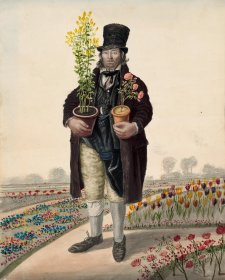Although a group of literary admirers established a Robert Bloomfield Society in 2000, it must be admitted that the poet is hardly well-known today. The best that could be claimed of his most celebrated work, The farmer’s boy, is that it has a kind of linguistic half-life, having introduced the caricature-name ‘Farmer Giles’ into colloquial usage.
Bloomfield’s verse was nevertheless immensely popular during his lifetime. The orphan son of a Suffolk tailor, he spent his adolescence on a relative’s farm before being apprenticed to his eldest brother George, a London shoemaker. The farmer’s boy was published in 1800 and became an immediate success, running to three editions in its first year of publication, reputedly selling over 26,000 copies in less than three years and being translated into French, Italian and even Latin. Such was the poem’s currency that it was presented on stage in the form of a pantomime performed at London’s Royal Circus. Everyone was talking about him: fellow poets William Wordsworth and John Clare and critics Robert Southey and William Hazlitt were all enthusiastic, though Lord Byron’s response was rather more cynical:
And now no Boor can seek his last abode,
No common be inclosed without an ode.
Oh! since increased refinement deigns to smile
On Britain’s sons, and bless our genial Isle,
Let Poesy go forth, pervade the whole,
Alike the rustic, and mechanic soul!
Ye tuneful cobblers! still your notes prolong,
Compose at once a slipper and a song;
So shall the fair your handywork peruse,
Your sonnets sure shall please — perhaps your shoes.
Charles Lamb was even more critical, writing to his friend Thomas Manning: ‘Don’t you think the fellow who wrote it … has a poor mind? Don’t you find he is always silly about poor Giles, and those abject kind of phrases which mark a man that looks up to wealth? What do you think? None of Burns’s poet dignity. I have just opened him, but he makes me sick.’ Still, irrespective of their literary merits, Bloomfield’s authentic descriptions of bucolic labour and natural beauty greatly enriched the contemporary discourse of landscape; the poem provided themes, subjects, titles and epigrams for a number of painters, including John Constable, John Glover and Sir George Beaumont.
Indeed, Bloomfield’s fame was such that his portrait was painted more than half a dozen times, with engraved versions appearing not only in his own books but in periodicals such as The Monthly Mirror and The European Magazine. Even the young American Rembrandt Peale, in London in 1802–03 to exhibit his father’s celebrated mastodon skeleton, took a likeness for the Peale ‘portrait factory’ in Philadelphia.
The poet attracted the patronage of the Duke of Grafton, and subsequent volumes of rural tales, ballads and songs also enjoyed a wide readership but, bankrupted by a failed bookselling venture and dogged by ill-health (or hypochondria), he spent his last 10 years in desperate poverty.
By the time that Dempsey saw him in 1823, Bloomfield’s season in the sun was pretty well over, despite having had a piece published in The Ladies’ Monthly Museum in that year. In Dempsey’s picture he is a tragic wreck, his thin, grizzled hair hanging lankly over his forehead and collar, his bloodshot, rheumy eyes staring vacantly into space. His coat is in rags: the right elbow is holed, a button on the left side hangs by a single thread. A web of yarn dangles off the end of his workbench, tacks and offcuts litter the ground. Even The farmer’s boy himself, the model of rural decorum, the shining example of Georgic virtue, is displaced and beaten by the forces of modern economics.
Yet, there is resistance here, too — a pathetic poet’s dignity. A small volume peeps from behind his right sleeve. There is a scroll of manuscript on the floor, and a bottle of ink and a quill stand amongst the shoe lasts, needles and knives.
Curiously, Dempsey’s watercolour seems at one point to have found its way into the hands of William Hone, author of The table book, who used it to illustrate (erroneously) an article on Bloomfield’s brother George.
Collection: Tasmanian Museum and Art Gallery, presented by C. Docker, 1956



Dempsey’s People curator David Hansen chronicles a research tale replete with serendipity, adventure and Tasmanian tigers.



Dempsey’s people: a folio of British street portraits 1824–1844 is the first exhibition to showcase the compelling watercolour images of English street people made by the itinerant English painter John Dempsey throughout the first half of the nineteenth century.



Visit us, learn with us, support us or work with us! Here’s a range of information about planning your visit, our history and more!